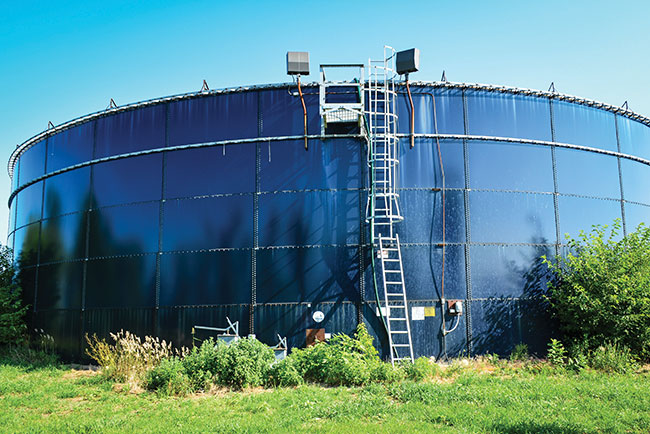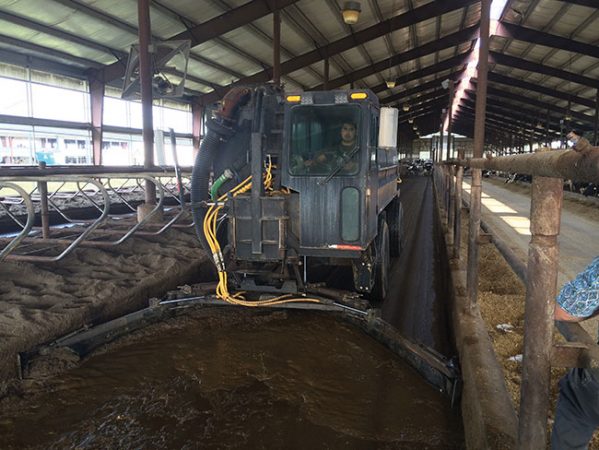
Features
Equipment
Gas safety
Safety
Storage
Storage safety
What you need to know about pit safety
Don’t take shortcuts, plan ahead and put steps in place to reduce risks and improve safety.
June 9, 2021 by Donna Fleury
 While some pit-related tasks only take place once or twice per year, safety is crucial at all times. Photo courtesy of Dan Andersen, Iowa State University.
While some pit-related tasks only take place once or twice per year, safety is crucial at all times. Photo courtesy of Dan Andersen, Iowa State University. Reducing risk and ensuring manure pit operation safety is very important for livestock producers. Although on some operations, this task only happens once or twice a year, planning ahead, developing Standard Operating Procedures (SOPs), ensuring everyone is trained and good communication helps reduce risk and keep everyone in the operation safe.
Of all the hazards, manure pit gases are considered the biggest concern for health and safety around manure handling and storage. Manure pit gases from any storage pit, whether closed or open or under barn storage, can be toxic to both humans and livestock. “Manure gases are the biggest risk for pit safety, with hydrogen sulfide (H2S) of top concern, and is extremely dangerous and highly unpredictable,” explains Dan Andersen, associate professor and extension specialist with Iowa State University. “When agitating and pumping manure, H2S is released, and the question is where does it end up?”
“Depending on the year, there are a few manure gas fatalities, usually related to H2S exposure,” says Josie Rudolphi, assistant professor and extension specialist with the University of Illinois. “H2S is tricky as it is colorless, flammable and extremely hazardous with a rotten egg smell. It is also heavier than air, which means it collects in lower lying and poorly ventilated areas. If it collects in low lying areas without good air movement, it is in the breathing zone for people and animals and can be immediately dangerous to life and health.”
Manure applicators and any individuals working around the barn and confined spaces are recommended to be equipped with H2S monitors or four-gas or multi-gas detectors that provide alerts when levels are increasing. This alert system gives workers time to move away from higher concentrations of H2S, or other gases such as methane, carbon monoxide and ammonia. At H2S levels of two to 20 ppm, symptoms can include nausea, headache and dizziness. At H2S levels greater than 100 ppm, the gas causes altered breathing, collapse and death. These monitors must be kept charged and more importantly calibrated frequently to ensure the gases are detected at the levels they need to be detected.
“Monitoring is very useful as gases like H2S can get extremely toxic in a hurry and at high levels can paralyze olfactory senses in the nose so you can no longer smell it,” explains Tracey Erickson, extension dairy field specialist with the South Dakota State University. “Methane is odorless and difficult to detect by smell, as is carbon dioxide. Exposure to ammonia results in immediate symptoms, with a burning sensation and redness in the eyes as the gas rises. At a minimum, all workers should have H2S or multi-gas monitors and understand the protocols for dealing with manure and manure gases. For larger operations, commercial manure handlers and producers dealing with manure on a regular basis, having a self-contained breathing apparatus or supplied air respirator is recommended. It is important to understand the different types of personal protective equipment [PPE] available and the differences in levels of protection each provides. And note that the masks we have been wearing recently for COVID-19 won’t provide adequate protection for manure handling.”
A buddy system is important in the event something happens and someone collapses. Any worker who enters the manure pit should wear a safety belt or harness as a lifeline in case of exposure and collapse. That allows people in the peripheral area to keep a safe distance away and pull them to safety. Anyone else trying to enter the exposed area to save the first victim face the same exposure, risking the lives of both victim and rescuer. The second person should be able to call for emergency help if needed, providing adequate directions and a description of the emergency hazard so emergency personnel are adequately prepared.

Risks are not limited to the manure pit itself – they are present in all aspects of handling and removal, mening ventilation is of the utmost importance. Photo courtesy of Tracey Erickson.
Safety considerations for manure handling and removal
The risks are not only limited to the manure pit itself, but also to all aspects of handling and removal. “Ventilation systems are really important, especially for enclosed barns, such as swine barns where the manure is stored in the barns,” says Andersen. “The goal of the ventilation system is to exhaust the gases out of the barn, and SOPs should ensure the ventilation system is set right to provide high ventilation rates while agitating and stirring up the manure. Also, check and make sure all of the fans are actually working and functioning properly. If it is a curtain-sided barn, check and make sure the curtains and inlets are operating properly. A word of caution to manure haulers who sometimes like to get out of the tractor to stretch their legs and walk around the barn. If they end up walking in front of the fans blowing out the H2S, they can be exposed to the gases.”
“The ventilation system must be properly functioning, both for people working in the area as well as animals,” adds Rudolphi. For example, in some Midwest hog facilities with underground manure pits, keeping the area well ventilated when agitating and removing the manure and moving out animals if possible during the process helps to keep them from being fatally exposed to gases. Andersen notes, “Think ahead to the process, make sure you are working with partners for any maintenance. If you are going into a confined space, make sure to ventilate the area for a period of time before entering. We highly recommend using a gas meter to test the space before entry, a bit like the canary in the coalmine without the canary. Lots of people do maintenance on the area around manure storage every year and it turns out fine, but every once in a while there is a case or two where it doesn’t, so caution is a good idea.”
“Lock out and tag out to make sure people can’t get into a confined space or through the fence without others knowing they are there,” explains Rudolphi. “For example, don’t start the pit agitating process if other co-workers or someone else is in the maintenance area or fixing the equipment. Keep people a safe distance away from the pit for 20 or 40 minutes until the pit has been adequately agitated. Fencing and signage are other important considerations around manure pits to ensure that children, visitors and animals are kept out. Placing signage that indicates hazardous gases are present provides a visual warning and helps people understand the risks and that it is an area of caution. Some jurisdictions require fencing around manure storage areas.”
Other safety considerations include access ramps to outside pits. Some pits were designed with good access ramps, while others were not. Because of these differences, it is important to develop SOPs that work for each individual site and do the best you can. Make sure to understand how to work around the access ramp, how to keep equipment out of the pit. Check to make sure parking brakes are working properly. General equipment maintenance, handling and basic safety are important.
“Road safety is another consideration when moving manure,” adds Andersen. “Manure equipment on the road is often moving slower than other drivers tend to think it is, increasing the risk of rear ending. If possible, try to pick routes where there is less traffic and try to avoid times of day when the roads are busier. Not everyone traveling in the country understands farm equipment very well and aren’t aware of the proper distance and space requirements.”
Safety, training and communication
“There are different hazards for producers working in the environment, and manure gases don’t always come to mind,” says Rudolphi. “In many operations, producers are rarely working with manure throughout the year, compared to equipment such as tractors or livestock that they are working with every single day. Similar to electricity, producers don’t often see the susceptibility or severity of manure gas hazards. Manure gases can be sort of out of sight out of mind, so building awareness and communication for everyone in the operation is key. There are various tools and resources that can assist producers, including a checklist for addressing the hazards around pit safety, including considerations before, during and after manure handling and disposal, to keep everyone in the environment safe.”
When developing SOPs and training around manure pits and other safety hazards, consider a safety hierarchy for controlling exposure. The first step is to try to eliminate or remove the hazard. With livestock operations, manure will always be produced and can’t be eliminated, so the next step is to prevent exposure to the hazard through engineering controls, warnings and training. And lastly, if exposure can’t be prevented such as working in and around manure pits, then consider the tools and PPE safety equipment required to manage and control exposure.
“Along with having SOPs and training plans in place, making safety a mindset and part of a thought process as you go through daily tasks, whether that is operating machinery, driving a car or handling manure is really important,” explains Erickson. “Often people get in too big of a hurry to do the next job and forget to slow down and take the time to evaluate the risks at hand. One way to evaluate risks and plan ahead before taking on any task is to use the SIPDE process, which is short for scan, identify, predict, decide and execute. This useful process helps identify and evaluate potential risks, predict possible outcomes, decide what actions to take and execute your decision.”
Erickson emphasizes that communication is very important for improving safety. “All of the people working around livestock operations and manure systems, whether family or employees or commercial applicators, must be made aware of and understand the dangers. They need to know how to operate all of the equipment and proper manure handling safety protocols. They need to know what they are doing when they go out there to do a task, and be confident and able to perform the task they are asked to do safely. Never assume people know how to do the things they are asked to do. And sometimes people on farming operations take risks that maybe they shouldn’t. Don’t wait until some unfortunate experience on the farm or with family or coworkers happens before making changes. Short cuts are not worth it, plan ahead and put steps in place to reduce risks and keep people and animals safe.” •